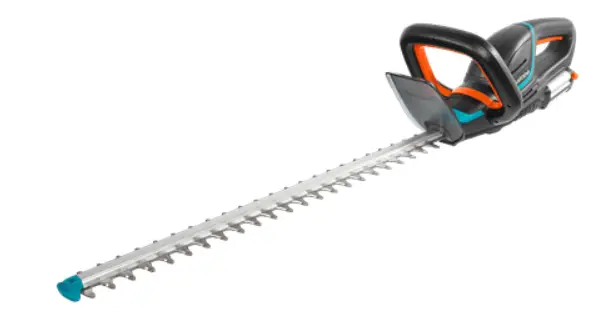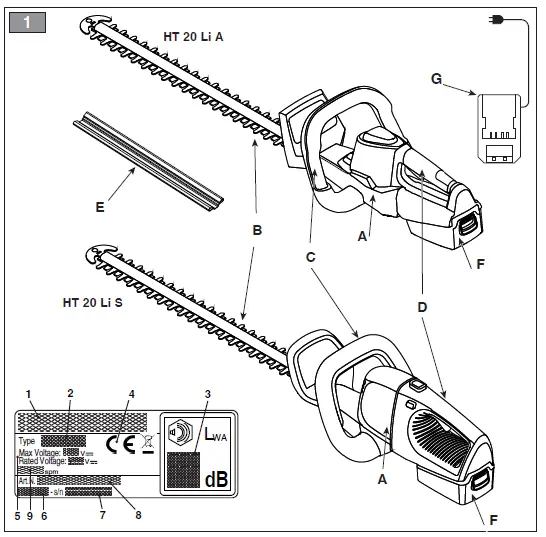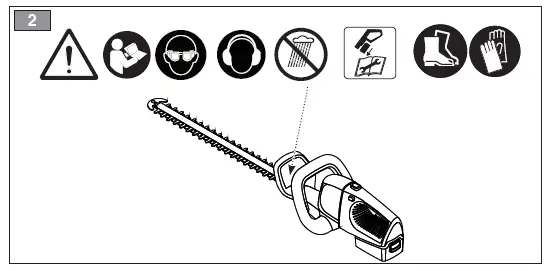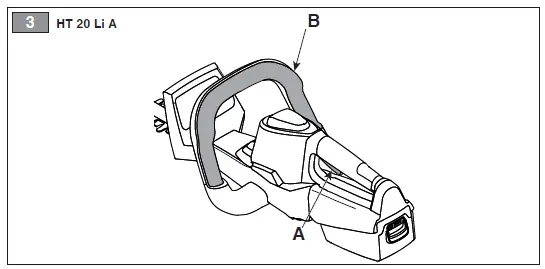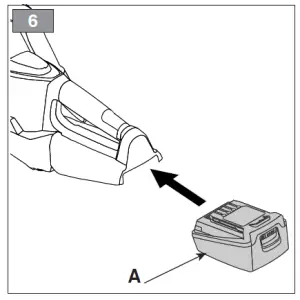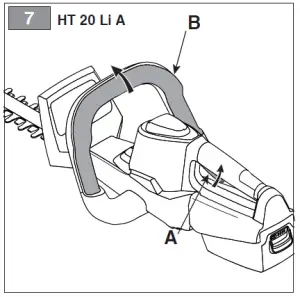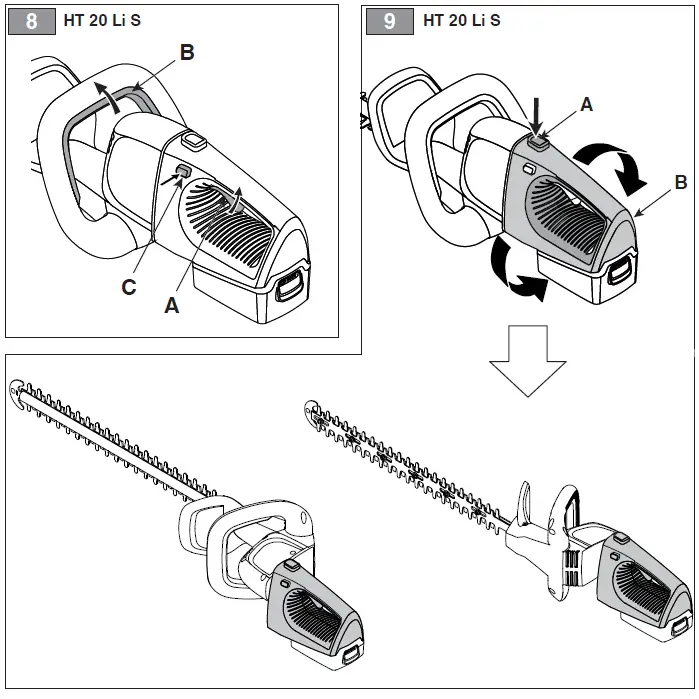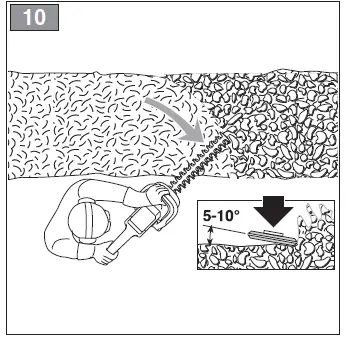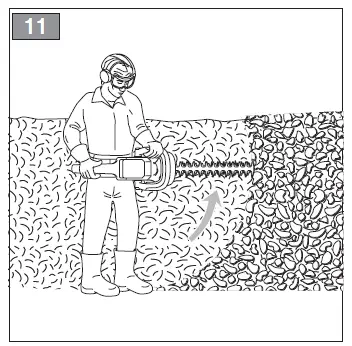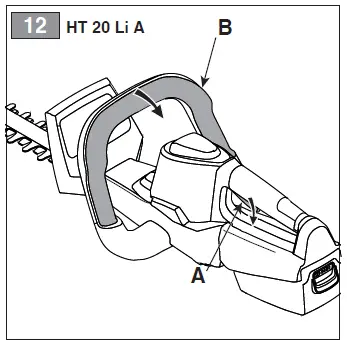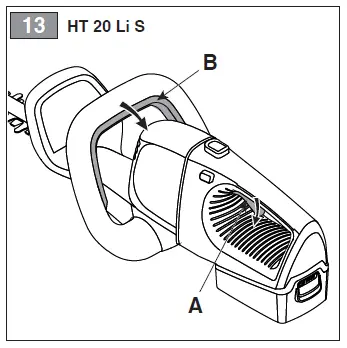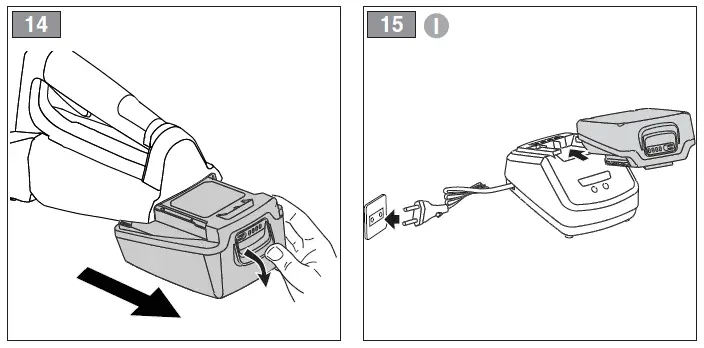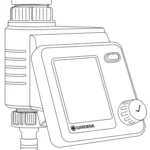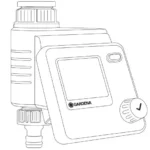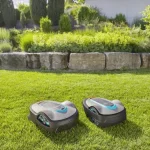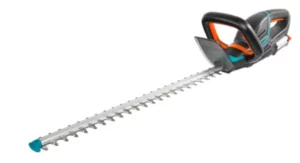
GARDENA Battery Powered Hedge Trimmer User Manual
GARDENA Battery Powered Hedge Trimmer
| �1� | TECHNICAL DATA | HT 20 Li S | HT 20 Li A | |
| �2� | Power supply frequency and voltage MAX | V / d.c. | 20 | 20 |
| �3� | Power supply frequency and voltage NOMINAL | V / d.c. | 18 | 18 |
| �4� | Blade speed | spm | 2300 | 2300 |
| �5� | Blade lenght | mm | 700 | 700 |
| �6� | Cutting lenght | mm | 500 | 500 |
| �7� | Cutting capacity | mm | 18 | 18 |
| �8� | Weight without battery pack | kg | 2,2 | 2,1 |
| �9� | Cutting means code | 118805318/0 | 118805318/0 | |
| �10�
�11� |
Measured sound pressure level
Uncertainty of measure |
dB(A)
dB(A) |
75,4
3 |
75,4
3 |
| �12�
�11� |
Measuered sound power level
Uncertainty of measure |
dB(A)
dB(A) |
85,2
0,78 |
85,2
0,78 |
| �13� | Guaranteed sound power level | dB(A) | 86 | 86 |
| �14�
�15� �16� �11� |
Vibration level
– Front handle – Rear handle Uncertainty of measure |
m/s2 m/s2 m/s2 |
0,80 1,12 1,5 |
0,80 1,12 1,5 |
| �17� | ACCESSORIES AVAILABLE ON REQUEST | ||
| �18� | Battery pack, model | BT 20 Li 2.0 S
BT 20 Li 4.0 S |
BT 20 Li 2.0 A
BT 20 Li 4.0 A |
| �19� | Battery charger | CG 20 Li
CGD 20 Li CGW 20 Li |
CG 20 Li
CGD 20 Li CGW 20 Li |
- NOTE: the declared total vibration value was measured using a normalised test method and can be used to conduct comparisons between one tool and another. The total vibration value can also be used for a preliminary exposure
- WARNING: the vibrations emitted during actual use of the tool can differ from the declared total value according to how the tool is Whilst working, therefore, it is necessary to adopt the following safety measures designed to protect the operator: wear protective gloves whilst working, use the machine for limited periods at a time and decrease the time during which the throttle control lever is pressed.
1. GENERAL INFORMATION
1.1 HOW TO READ THIS MANUAL
NOTE or IMPORTANT These give details or further information on what has been previously indicated and aim to prevent damage to the machine or cause other damage.
The symbol highlights danger. Failure to observe the warning can lead to possible
personal and/or third party injury and/or damage.
The paragraphs highlighted in a dotted grey square indicate optional characteristics not available on all models documented in this manual. Check if the characteristics a re available on this model.
Whenever reference is made to a position on the machine “front”, “back”, “left” or “right” hand side, this refers to the operator’s working position.
2. SAFETY REGULATIONS
2.1 GENERAL SAFETY WARNINGS
Read all safety warnings, instructions, illustrations and specifications. provided with this power tool. Failure lo follow
all instructions listed below may result in electric shock, fire and/or serious injury.
Save all warnings and instructions for future reference.
The term “power tool” in the warnings refers to your mains-opera/eel (cordecl) power tool or battery-operated (cordless) power tool.
1) Work area safety
A Keep work area clean and well
Cluttered or dark areas invite accidents.
b) Do not operate power tools in explosive atmospheres, such as in the presence of flammable liquids,
gases or dust. Power tools create sparks which may ignite the dust or fumes.
c) Keep children and bystanders well away while using power tools.
Distractions can cause you to lose control.
2) Electrical safety
a) Avoid body contact with earthed or grounded surfaces, such as pipes, radiators, cookers and refrigerators. There is an increased risk of electric shock if your body is earthed or grounded.
b) Do not expose power tools to rain or wet environments. Water entering a power tool will increase the risk of electrical shock.
3) Personal safety
a) Stay alert, check what you are doing and use common sense when using a power tool. Do not use the power tool when you are tired or under the influence of drugs, alcohol or medicines. A moment of inattention while operating a power tool may result in serious personal injury.
b) Use personal protective equipment. Always wear eye protection. Protective equipment such as a dust mask, non-skid safety shoes, hard hat or hearing protection used for appropriate conditions will reduce personal injuries.
c) Prevent unintentional starting. Make sure the appliance is turned off before inserting the battery pack, picking up or carrying the power tool. Carrying power tools with your finger on the switch or mounting the battery with the switch in “ON” position invites accidents.
d) Remove any adjusting key or wrench before turning the power tool on. A wrench or a key left attached to a rotating part of the machine may result in personal injury.
e) Do not overreach. Keep proper footing and balance at all times. This enables better control of the power tool in unexpected situations.
f) Dress properly. Do not wear loose clothing or jewellery. Keep your hair and clothing away from moving parts. Loose clothes, jewellery or long hair can be caught in moving parts.
g) If devices are provided for the connection of dust extraction and collection facilities, ensure these are connected and properly used. Use of dust collection can reduce dust-related hazards.
6) Service
a) Have your power tool serviced by a qualified repair person using only identical replacement parts. This will ensure that the safety of the power tool is maintained.
b) Never service damaged battery packs. Service of battery packs should only be performed by the manufacturer or authorized service providers.
2.2 SPECIFIC SAFETY REGULATIONS FOR HEDGE TRIMMERS
- During work operations, always hold the machine firmly with both hands. Operating it with only one hand can cause loss of control and serious personal injury
- Keep all parts of the body away from the blade. Do not remove cut material or hold material to be cut when blades are moving. Blades continue to move after the switch is turned off. A moment of inattention while operating the hedge trimmer may result in serious personal injury.
- Carry the hedge trimmer by the handle with the blade stopped and taking care not to operate any power switch. Proper carrying of the hedge trimmer will decrease the risk of inadvertent starting and resultant personal injury from the blades.
- Hold the power tool by insulated gripping surfaces only, because the blade may come in contact with hidden wiring. Contact between cutter blades and a “live” wire may cause exposed metal parts of the tool to become “live” and give the operator an electrical shock.
- When transporting or storing the hedge trimmer, always fit the blade cover. Proper handling of the hedge trimmer will decrease the risk of personal injury from the blades.
- Do not use the hedge trimmer in bad weather conditions, especially when there is a risk of lightning. This decreases the risk of being struck by lightning.
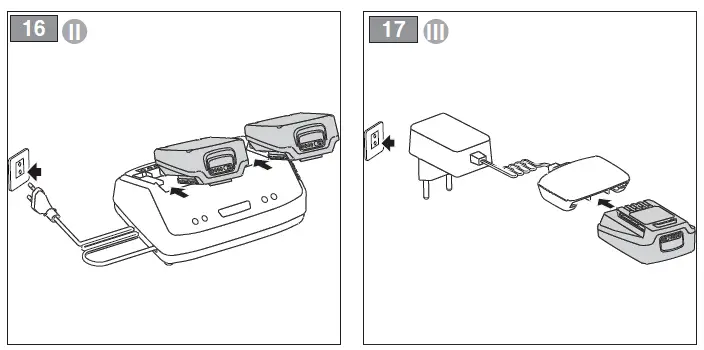 If something breaks or an accident occurs during work, turn off the motor immediately and move the machine away to prevent further damage; if an accident occurs with injuries or third parties are injured, carry out the first aid measures most suitable for the situation immediately and contact the medical authorities for any necessary health care. Carefully remove any debris which could cause damage or injury to persons or animals if ignored.
If something breaks or an accident occurs during work, turn off the motor immediately and move the machine away to prevent further damage; if an accident occurs with injuries or third parties are injured, carry out the first aid measures most suitable for the situation immediately and contact the medical authorities for any necessary health care. Carefully remove any debris which could cause damage or injury to persons or animals if ignored.
 Prolonged exposure to vibrations can cause injuries and neurovascular disorders (also called “Raynaud’s syndrome” or “white finger”), especially to people suffering from circulation disorders. The symptoms can regard the hands, wrists and fingers and are shown through loss of sensitivity, torpor, itching, pain and discolouring of or structural changes to the skin. These effects can be worsened by low ambient temperatures and/or by gripping the hand grips excessively tightly. If the symptoms occur, the length of time the machine is used must be reduced and a doctor consulted.
Prolonged exposure to vibrations can cause injuries and neurovascular disorders (also called “Raynaud’s syndrome” or “white finger”), especially to people suffering from circulation disorders. The symptoms can regard the hands, wrists and fingers and are shown through loss of sensitivity, torpor, itching, pain and discolouring of or structural changes to the skin. These effects can be worsened by low ambient temperatures and/or by gripping the hand grips excessively tightly. If the symptoms occur, the length of time the machine is used must be reduced and a doctor consulted.
2.3 ENVIRONMENTAL PROTECTION
- Scrupulously comply with local regulations for the disposal of packaging, deteriorated parts or any elements with a strong environmental impact; this waste must not be disposed of with regular waste, but must be separated and taken to collection centres, which will recycle the materials.
- Scrupulously comply with local regulations for the disposal of waste materials
- When the machine is withdrawn from service, do not dispose of it in the environment, but take it to a waste disposal facility in accordance with the local regulations in force.
 Do not throw electrical equipment away with domestic waste. According to the European Directive 2012/19/EU on electrical and electronic equipment waste and its implementation in compliance with national standards, old electrical equipment must be collected separately, for eco-compatible recycling. If electrical equipment is disposed of in a landfill or in the ground, the harmful substances can reach the water table and enter the food chain, damaging your health and well-being. For further information on the disposal of this product, contact your dealer or a domestic waste collection service.
Do not throw electrical equipment away with domestic waste. According to the European Directive 2012/19/EU on electrical and electronic equipment waste and its implementation in compliance with national standards, old electrical equipment must be collected separately, for eco-compatible recycling. If electrical equipment is disposed of in a landfill or in the ground, the harmful substances can reach the water table and enter the food chain, damaging your health and well-being. For further information on the disposal of this product, contact your dealer or a domestic waste collection service.
 At the end of their working life, dispose of batteries paying due attention to the environment. Batteries contain material classified as hazardous for you and the environment. They must be removed and disposed of separately at a facility that accepts lithium-ion batteries.
At the end of their working life, dispose of batteries paying due attention to the environment. Batteries contain material classified as hazardous for you and the environment. They must be removed and disposed of separately at a facility that accepts lithium-ion batteries.
 Separate waste collection of the products and packaging used allows the materials to be recycled and reused. Reuse of recycled materials help to prevent environmental pollution and reduces the demand for raw materials.
Separate waste collection of the products and packaging used allows the materials to be recycled and reused. Reuse of recycled materials help to prevent environmental pollution and reduces the demand for raw materials.
3.ABOUT THE MACHINE
3.1 MACHINE DESCRIPTION AND INTENDED USE
This machine is a garden tool and more precisely a battery-powered portable hedge trimmer.
The machine is essentially composed of a motor which drives a cutting means.
The operator can operate the machine and use the main controls, always keeping a safe distance from the cutting means.
3.1.1 Intended use
This machine was designed and manufactured for:
- cutting and trimming bushes and hedges comprising shrubs with small branches
- being used by one operator.
3.1.2 Improper use
- Any other use that does not comply with the above, can be dangerous and cause damage to people and/or property. Examples of improper use may include, but are not limited to:
- cutting grass in general and in particular close to kerbs;
- shredding of materials for composting;
- pruning;
- using the machine with the cutting means above the operator’s shoulder level;
- use of the machine for cutting non-plant material;
- using cutting means other than those found in the “Technical Data” table. Risk of serious injury and injuries;
- using of the machine by more than one person.
IMPORTANT Improper use of the machine will void the warranty and relieves the Manufacturer of any liability, placing all responsibility for damage or injury, to him/herself or third parties, on the user.
3.1.3 Type of users
This machine is intended for use by consumers, i.e. non-professional operators. It is intended for “hobby-related activities”.
3.2 MAIN COMPONENTS (Fig.1 )
A. Engine: supplies the drive power to the cutting means.
B. Blade (cutting means): the element designed to cut the vegetation.
C. Front hand grip: used to handle the machine and equipped with the safety switch.
D. Rear hand grip: used to handle the machine and equipped with the main control buttons.
E. Blade protection (for machine transport and handling): protects against accidental contact with the cutting means that can cause serious injuries.
F. Battery (if not supplied with the machine, see chapter : 13 “optional attachments”
device that supplies electric current to the tool; its specifications and regulations for use are described in a specific manual.
G. Battery charger (if not supplied with the machine, see chapter : 13 “optional attachments” device used to recharge the battery; its specifications and regulations for use are described in a specific manual.
3.3 PRODUCT IDENTIFICATION LABEL (Fig.1 )
- CE conformity marking
- Name and address of Manufacturer
- Sound power level
- Article code
- Type of machine
- Serial number
- Year of manufacture
- Power voltage and frequency
- Blade speed
Write the identification data of the machine in the specific space on the label on the back of the cover page.
IMPORTANT Quote the information on the product identification label whenever you contact an Authorised Service Centre.
IMPORTANT An example of the Declaration of Conformity is provided on the last pages of this manual.
3.4SAFETY SIGNS (Fig.2 )
The machine has various symbols on it.
Meanings of the symbols:
 WARNING! DANGER! The failure to use this machine correctly can be hazardous for oneself and others.
WARNING! DANGER! The failure to use this machine correctly can be hazardous for oneself and others.
WARNING! Read the owner’s manual before using the machine.
5.3 SAFETY SWITCH
The safety switch on the front handle (Fig. 3.B, Fig. 4.B) provides additional safety, since it must be held down together with the blade control lever in order to operate the cutting device.
The cutting device stops automatically when the safety switch is released.
5.4 REAR HANDGRIP RELEASE BUTTON (MOD. HT 20 LI S)
The release lever (Fig. 4.D) is used to adjust the rear handgrip (Fig. 1.D) to 3 different positions in relation to the cutting means to make trimming your hedges easier (par 6.4.1).
 The handgrip must only be adjusted when the machine is switched off.
The handgrip must only be adjusted when the machine is switched off.
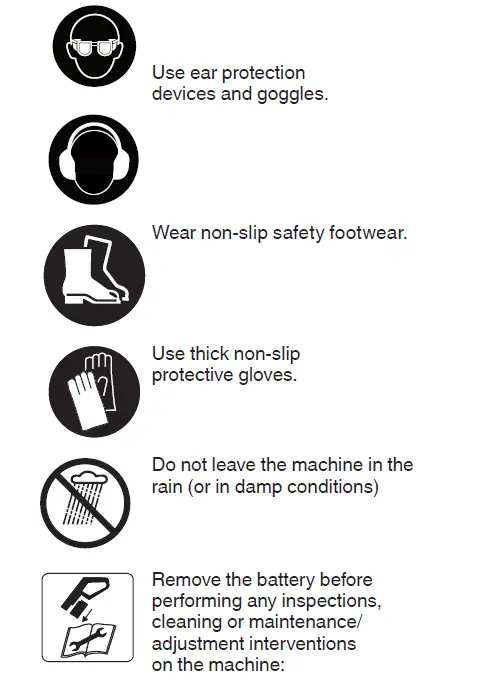
IMPORTANT Any damaged or illegible decals must be replaced. Order replacement decals from an Authorised Service Centre.
4. UNPACKING
IMPORTANT The safety standards to be followed are described in chapter. 2. Strictly comply with these instructions to avoid serious risks or dangers.
 Unpacking should be done on a flat and stable surface, with enough space for machine handling and its packaging, always making use of suitable equipment.
Unpacking should be done on a flat and stable surface, with enough space for machine handling and its packaging, always making use of suitable equipment.
- .Carefully open the packaging, paying attention not to lose components.
- Consult the documentation in the box, including these instructions.
- Remove the machine from the box.
- Dispose of the box and packaging in compliance with local regulations.
5. CONTROLS
5.1 BLADE CONTROL LEVER
- The blade control lever (Fig. 3.A, Fig. 4.A) allows the blade (cutting device) to be operated.
- Model HT 20 Li A
Operating the cutting device is only possible if the blade control lever (Fig. 3.A) and the safety switch (Fig. 3.B) are pressed simultaneously. - Modello HT 20 Li S
Operating the cutting device is only possible if the blade control lever (Fig. 4.A) and the blade control locking button (Fig. 4.C) and the safety switch (Fig. 4.B) are pressed simultaneously.
The cutting device stops automatically when the lever is released.
5.2 BLADE CONTROL LOCKING BUTTON (MOD. HT 20 LI S)
The blade control locking button (Fig. 4.C) allows operation of the blade control lever (Fig. 4.A).
5.3 SAFETY SWITCH
The safety switch on the front handle (Fig. 3.B, Fig. 4.B) provides additional safety, since it must be held down together with the blade control lever in order to operate the cutting device.
The cutting device stops automatically when the safety switch is released.
5.4 REAR HANDGRIP RELEASE BUTTON (MOD. HT 20 LI S)
The release lever (Fig. 4.D) is used to adjust the rear handgrip (Fig. 1.D) to 3 different positions in relation to the cutting means to make trimming your hedges easier (par 6.4.1).
 The handgrip must only be adjusted when the machine is switched off.
The handgrip must only be adjusted when the machine is switched off.
6. USING THE MACHINE
IMPORTANT The safety standards to be followed are described in chapter. 2. Strictly comply with these instructions to avoid serious risks or dangers.
6.1 PRELIMINARY OPERATIONS
Place the machine in a stable horizontal position on the ground.
6.1.1 Checking and recharging the battery (Fig. 5)
Before each use check the battery charge status according to the instructions in the battery booklet.
6.2 SAFETY CHECKS
 Always carry out the safety checks before use.
Always carry out the safety checks before use.
6.2.1 General check
| Object | Result |
| Handgrips (Fig. 1.C, Fig. 1.D) and guards | Are clean, dry and fixed firmly to the machine |
| Screws on the machine and blade | Correctly tightened (not loose) |
| Cooling air ducts | Not clogged |
| Blade (Fig. 1.B) | Sharp, not damaged or worn, well sharpened. |
| Guards | Intact, undamaged. |
| Battery (Fig. 1.F) | No damage to the casing, no liquid leakage. |
| Machine | No signs of damage or wear. No abnormal vibrations.
No abnormal sound. |
| Levers, buttons, and safety switches | They must move freely, not be forced and when released they must return automatically and rapidly to the neutral position. |
| Action | Result |
| 1. Start the machine
(para. 6.3 ); 2. Release the blade control lever (Fig. 3.A, Fig. 4.A) or the safety switch (Fig. 3.B, Fig. 4.B) |
1. The blade should move
2. The controls should return automatically and rapidly to the neutral position and the blade should stop |
 If any of the results fail to match the indications provided in the tables below, do not use the machine! Take it to a service centre to be checked and repaired if necessary.
If any of the results fail to match the indications provided in the tables below, do not use the machine! Take it to a service centre to be checked and repaired if necessary.
6.3 START-UP
 Starting the machine causes the simultaneous engagement of the blade.
Starting the machine causes the simultaneous engagement of the blade.
NOTE Operate the machine only on a firm, level surface.
- Remove the blade guard (Fig. 1.E) (if used)
- Make sure the blade is not touching the ground or any other object
- Fit the battery (Fig. 6.A) inside its housing pressing down until you hear it clicks firmly into position and assure the electrical contact
- Take a firm and balance position
5.a Mod. HT 20 Li A
–– Simultaneously operate the blade control lever (Fig. 7.A) and the safety switch (Fig. 7.B),
5.b Mod. HT 20 Li S
–– Simultaneously operate the blade control lever (Fig. 8.A), blade control locking button (Fig. 8.C) and the safety switch (Fig. 8.B).
6.4 OPERATION
 During use, always hold the machine firmly with two hands, using the machine with the cutting means under the operator’s shoulder level.
During use, always hold the machine firmly with two hands, using the machine with the cutting means under the operator’s shoulder level.
 Always use the machine at ground level and not on ladders or any other unstable support.
Always use the machine at ground level and not on ladders or any other unstable support.
 Do not remove cut material or hold material to be cut when blades are moving. Make sure the machine is turned off when removing cut material.
Do not remove cut material or hold material to be cut when blades are moving. Make sure the machine is turned off when removing cut material.
NOTE During use, the battery is protected against total drainage with a protective device that switches off the machine and stops it from working.
6.4.1Adjusting the rear handgrip (Mod. HT 20 Li S)
 Perform this operation with the machine off.
Perform this operation with the machine off.
- Press the rear handgrip release button (Fig. 9.A); (Fig. 9.A)
- Start rotating the rear handgrip (Fig. 9.B)
- Release the button
- Rotate the handgrip until it clicks into the desired position.
IMPORTANT Before using the machine check that the release button has correctly returned to the block position, and the rear handgrip is firmly attached.
 When working, the rear handgrip must always be in a vertical position, whatever the position of the cutting means.
When working, the rear handgrip must always be in a vertical position, whatever the position of the cutting means.
6.4.2 Work techniques
It is recommended to trim the two vertical sides of the hedge before trimming the top.
NOTE Battery power reserve (and therefore the cuttable vegetation area before recharging is required) depends on many factors described in (para. 7.2.1).
- Vertical cutting
Proceed by cutting using curved movements from the bottom towards the top, keeping the blade as far from the body as possible (Fig. 10).
- Horizontal cutting
The best results will be obtained with the blade slightly inclined (5° – 10°) in the direction you are cutting, proceed with a curved movement, slowly and without interruptions, especially
in the case of very thick hedges (Fig.11).
6.4.3 Advice for operation
If the blades block while running or get caught up in the hedge branches:
- Release the blade control lever (Fig. 12.A, Fig. 13.A) or the safety switch (Fig. 12.B, Fig. 13.B) immediately;
- Wait for the cutting means to come to a halt
- Remove the battery (para. 7.2.2)
- Remove the jammed material.
6.4.4 Lubricating the blades whilst working
If the cutting means overheats whilst working, it is necessary to lubricate the internal surfaces of the blades (para. 7.4).
This operation can only be done with the machine off and the battery removed from its housing.
6.5 STOP
- Release the blade control lever (Fig. A, Fig. 13.A) or the safety switch (Fig. 12.B, Fig. 13.B).
When you have stopped the machine, it will take a few seconds for the cutting means to stop.
Always stop the machine when moving between work areas.
Do not keep your hand on the safety switch when moving the machine to avoid accidentally starting the machine.
6.6 AFTER USE
- Remove the battery from its housing and recharge it (para. 2.2).
- When the cutting means has halted, fit the blade guard (Fig. 1.E).
- Allow the engine to cool before storing in an enclosed space.
- Clean (para. 3).
- Check there are no loose or damaged If necessary, replace the damaged components and tighten any screws and loose bolts or contact the authorised service centre.
- Check there are no damages to the If necessary contact the authorised service centre.
IMPORTANT Always remove the battery (para. 7.2.2) and fit the blade guard whenever the machine is unused or left unattended.
7. MAINTENANCE
7.1 GENERAL INFORMATION
IMPORTANT The safety standards to be followed are described in chapter. 2. Strictly comply with these instructions to avoid serious risks or dangers.
Before performing any inspections, cleaning or maintenance/adjustment interventions on the machine:
- Stop the machine
- Remove the battery from its housing and recharge it (para. 2.2) (never leave the battery inserted or within the reach of children or unauthorised persons)
- When the cutting means is stationary, apply the blade protection device, (except when working directly on the blade)
- Allow the engine to cool before storing in an enclosed space
- Use suitable clothing, protective gloves and goggles
- Read the relevant
IMPORTANT Any maintenance and adjustment operations not described in this manual must be carried out by your dealer or Authorised Service Centre.
7.2 BATTERY
7.2.1 Battery power reserve
Battery power reserve (and therefore the cuttable vegetation area before recharging is required) mainly depends on:
- Environmental factors, that cause higher energy requirements:
- cutting/trimming of very thick or wet hedges;
- cutting/trimming of bushes with branches that are too thick;
- operator behaviour that should be avoided:
- switching the machine on and off frequently whilst working;
- adopting a cutting technique that is unsuitable for the work to be performed (para. 4.1);
- cutting speed unsuitable for the condition of the hedge to be To optimise battery power reserve it is always recommended to
- cut the hedge when dry;
- set a cutting speed suitable for the condition of the shrubs;
- use the most appropriate technique for the work to be
If the need arises to use the machine for sessions which exceed the capability of a standard battery, it is possible to:
- purchase a second standard battery to immediately replace the discharged battery, without compromising
the continuity of operations;
- purchase a battery with an extended power reserve compared to the standard version (para. 1).
7.2.2 Battery removal and recharging (Fig.14÷17)
Fully charge the battery according to the instructions in the battery/battery charger booklet.
NOTE The battery is equipped with a guard that inhibits recharging if the environmental temperature is not between 0 and +45°C.
NOTE The battery can be recharged at any time, even partially, with no risk of damaging it.
7.3 CLEANING THE MACHINE
- To reduce fire hazards, keep the machine and, in particular, the motor free of leaves, branches or excessive
- Always clean the machine after use with a damp cloth dipped in neutral
- Remove all traces of humidity using a soft damp cloth. Humidity can generate risks of electric shocks.
- Do not use aggressive detergents or solvents to clean the plastic parts or hand
- Do not spray water onto the motor and electrical components and prevent them from getting
- To avoid overheating and damage to the motor or the battery, always keep the cooling air vents clean and free of
7.4 CLEANING AND LUBRICATION OF THE CUTTING MEANS
To increase the efficiency and working life of the blades, clean and lubricate them carefully after each work session:
Do not touch the cutting device until the battery has been removed and the cutting device is completely stationary.
- Place the machine in a stable horizontal position on the
- Use a soft cloth to clean the blades, along with a brush to remove more difficult dirt and debris.
- Lubricate the blades by applying a light layer of specific oil, preferably the non-pollutant type, along the upper edge of the
7.5 NUTS AND BOLTS
- Keep all nuts, bolts and screws tight to be sure the equipment is in safe working condition.
- Check regularly that the handles are fixed firmly.
7.6 CUTTING MEANS
Do not touch the cutting means until the battery has been removed and the cutting means is completely stationary.
7.6.1 Checks
Periodically check that the blades are not bent, damaged or deformed and that the screws are adequately tightened.
Adjustment of the distance between blades is not necessary, as this is predetermined by the manufacturer.
7.6.2 Sharpening
It is necessary to sharpen the blades when the trimming performance decreases and the branches tend to stick together.
For safety reasons, sharpening must be done by an Authorised Service Centre with suitable skills and equipment for the
job; without risking any damage to the blade which would make it unsafe when used.
Always replace and never repair a blade which has blunt cutting edges.
7.6.3 Replacement
The blade must never be repaired, but must be replaced as soon as signs of breaking, wearing, bending are noted or the sharpening limit is exceeded. For
safety reasons replacements must be performed by an Authorised Service Centre.
Blades displaying the code indicated on the Technical Data table should be used on this machine.
Given product evolution, the blades listed in the “Technical Data” table may be replaced in time with others having similar interchangeable and operating safety features.
8. STORAGE
IMPORTANT The safety regulations to follow for putting into storage are described in paragraph 2.4. Strictly comply with these instructions to avoid serious risks or hazards.
8.1 STORING
When the machine is to be stored away:
- Remove the battery from its housing and recharge it (para. 2.2)
- When the cutting means has halted, fit the blade guard
- Allow the engine to cool before storing in an enclosed space
- Clean (para. 3);
- Make sure there are no loose or damaged components. If necessary, replace any damaged components and tighten any screws and loose bolts or contact the authorised service centre;
- Store the machine:
- in a dry place;
- protected from inclement weather;
- in a place out of children’s reach;
- making sure that keys or tools used for maintenance are
9. HANDLING AND TRANSPORT
Whenever the machine is to be handled or transported you must:
- Stop the machine (para. 6.5);
- Make sure that all moving parts have come to a complete stop
- Remove the battery from its housing and recharge it (para. 2.2)
- Wear protective work gloves
- When the cutting means has
halted, fit the blade guard
- Only hold the machine using the hand grips and position the cutting means in the opposite direction to that used during operations
- Make sure that machine movements do not cause damage or injuries
10. ASSISTANCE AND REPAIRS
This manual provides all the necessary information to run the machine and for correct basic maintenance operations which can be performed by the user. Any regulations and maintenance operations not described herein must be carried out by your Dealer or Authorised Service Centre. Any operations performed in unauthorised centres or by unqualified persons will totally invalidate the Warranty and all obligations and responsibilities of the Manufacturer.
- Non-original parts and attachments are not approved; use of non-original spare parts and attachments will jeopardise the safety of the machine and relieve the
Manufacturer from all obligations or liabilities. - Original spare parts are supplied by authorised Dealers and by Authorised Service.
11. WARRANTY COVERAGE
The warranty conditions are intended for consumers only, i.e. non-professional operators.
The warranty covers all material quality and manufacturing defects recognised during the warranty period by your Dealer or Authorised Service Centre. The warranty is restricted.
to the repair or replacement of components recognised as faulty.
The warranty only applies to machines subjected to regular maintenance. The warranty does not cover damages resulting from:
- Failure to become familiar with the documentation accompanying the machine (Instruction manuals).
- Professional
- Carelessness,
- External causes (lightning, impact, presence of foreign bodies inside the machine) or
- Incorrect use or assembly are prohibited by the
- Poor
- Modification to the
- Use of non-genuine spare parts (adaptable parts).
- Use of accessories not supplied or approved by the
The warranty does not cover:
- The maintenance operations (described in the instruction manual).
- Normal wear and tear of
- Normal wear and
- Deterioration in the appearance of the machine due to
- Any ancillary expenses related to the enforcement of the warranty, such as costs incurred to travel to the user’s location, transfer of the machine to the Dealer, rental of
replacement equipment or calling of independent enterprises to perform maintenance work.
The user is protected by his or her own national legislation. The user’s rights under the national laws or his or her own country are not in any way restricted by this warranty.
12. TROUBLESHOOTING
| PROBLEM | PROBABLE CAUSE | SOLUTION |
| 1. Blade control lever and safety switch operated but the machine will not start (mod. HT 20 Li A)
or 2. Blade control lever, blade control locking button and safety switch operated but the machine will not start (mod. HT 20 Li S) |
Battery is not inserted or is inserted incorrectly | Make sure that the battery is inserted correctly (Fig. 6.A) |
| Low battery | Check the battery status and recharge if necessary (para. 7.2.2) | |
| Hedge trimmer is damaged. | Do not use the hedge trimmer. Remove the battery and contact an authorised service centre. | |
| 3. The motor shuts down whilst working | Battery is not inserted correctly | Make sure that the battery is inserted correctly (Fig. 6.A)) |
| Low battery | Check the battery status and recharge if necessary. (para. 7.2.2) | |
| 4. The cutting means is stationary when the blade control lever and safety switch are engaged (mod. HT 20 Li A)
or 5. The cutting means is stationary when the blade control lever, blade control locking button and safety switch are engaged (mod. HT 20 Li S) |
Hedge trimmer is damaged. | Do not use the hedge trimmer. Immediately turn off the machine remove the battery and Contact an Authorised Service Centre. |
| 6. The cutting means overheats whilst working | Insufficient blade lubrication | Turn off the machine, wait until the cutting means is stationary, remove the battery and lubricate the blades (para. 7.4) |
| PROBLEM | PROBABLE CAUSE | SOLUTION |
| 7. The cutting means comes into contact with a line or electric cable | – | DO NOT TOUCH THE BLADE AS IT MAY BE LIVE AND BE EXTREMELY
DANGEROUS! Grasp the machine using the insulated rear handgrip only and position it at a safe distance from yourself. Disconnect the current that powers the severed line or mains cable and remove the battery before freeing the blade teeth. |
| 8. The cutting means comes into contact with a foreign body. | – | Turn off the machine remove the battery and:
– Inspect for damage – Check for and tighten any loose parts – Contact an Authorised Service Centre for replacement or repair damaged parts with parts having equivalent specifications. |
| 9. Excessive noise and/or vibration is experienced whilst working | Loose or damaged parts | Turn off the machine remove the battery and:
– inspect for damage; – check for and tighten any loose parts; – Contact an Authorised Service Centre for replacement or repair damaged parts with parts having equivalent specifications. |
| 10. The machine gives off
smoke whilst working |
Hedge trimmer is damaged. | Do not use the hedge trimmer. Immediately turn off the machine remove the battery and Contact an Authorised Service Centre. |
| 11. Battery power reserve is low | Severe working conditions requiring greater
current absorption |
Optimise operations (para. 7.2.1) |
| Battery is insufficient for
operating requirements |
Use a second battery or an
extended battery (para. 13.1) |
|
| Decrease in battery capacity | Purchase a new battery | |
| 12. The battery charger is not recharging
the battery |
Battery is not correctly inserted in the battery charger | Check it is correctly inserted (para. 7.2.2) |
| Unsuitable environmental conditions | Recharge the battery in places with suitable temperatures (see battery/ battery charger instruction manual) | |
| Dirty contacts | Clean the contacts | |
| The battery charger is not energised | Check it is plugged in and the power socket is energised | |
| Faulty battery charger | Replace with an original spare part | |
| If the problem persists, refer to the battery/ battery charger manual |
If problems persist after implementing the solution, contact your Dealer.
13. ACCESSORIES ON REQUEST
13.1 BATTERIES
Different capacity batteries are available to suit specific operating requirements (Fig. 18). The list of approved batteries for this machine can be found in the “Technical Data” table
13.2 BATTERY CHARGER
Device used to recharge the battery (Fig.19).
